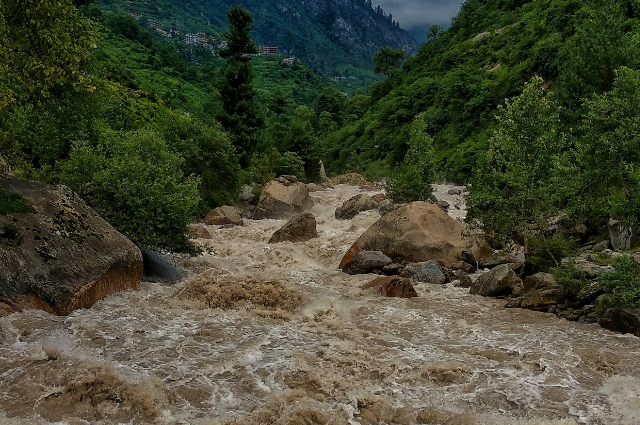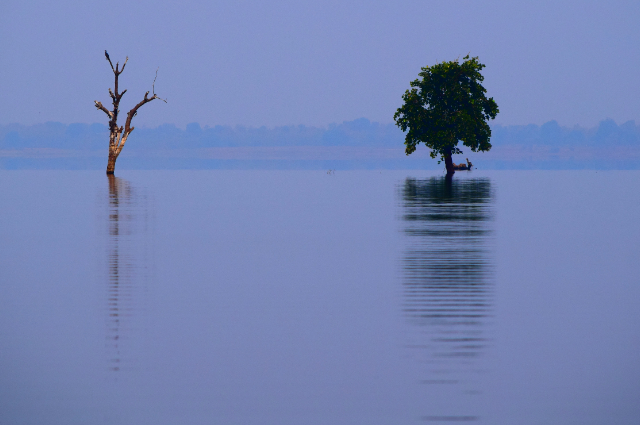
“Men argue. Nature acts.” –Voltaire.
Literature beautifully personifies nature and the natural world, using words to breathe life into what humans perceive as superficial, what we take for granted. We want the trees and rivers for their beauty and serenity, but rarely understand that nature is alive and has sustained mankind for centuries. But it has never been so exploited and threatened as it is now. And who is responsible?
I’ve been hearing how some of us are terrified by what the people around the world have been experiencing. Natural calamities are not just accidents anymore; they are a warning to mankind. How hard is it for us to understand that nature is striking back because we haven’t been wise and mindful?
A few days ago, I sat down to make a list of activities I witnessed around my neighbourhood. Activities that harm our environment have become the norm in our cities. During one of my morning walks, I saw a middle-aged man drive past me, and as he accelerated, he flung two polythene bags close to the drain right beside the footpath. When I crossed the same area in the afternoon, that spot had turned into a hill of garbage. Soon, I learnt that in many Indian cities, especially the tier one cities, the urban waste is disposed of in landfills close to the settlements and not on the outskirts. People casually discard their household waste on the side of the roads and think that somehow it will dissolve in the mighty air. They look away while throwing their garbage –proving that they’re guilty of causing this mess, but they won’t stop.
Likewise, the number of vehicles on our roads has gone up, and the level of harmful gases released every day is also increasing. Lately, I argued with someone about how not every human on this planet ‘needs’ a car.
In addition to that, despite restrictions during the recent Ganesh Visarjan, I spotted people tossing off every item they could find into the lakes —plastic flowers and decorations as well.
When I moved into my current residence, it was surrounded by large trees in all four corners and provided much-needed shade and fresh air. Now, after two years, not a single tree has survived. They were brutally cut down to make space for the construction of houses. The house owner made no move to save those trees, nor did the neighbours, who casually stood at their balconies watching the felling of beautiful, dense trees. ‘The tree is on their plot. If they don’t cut them, how will they construct the building?’
We, humans, have been accused of misusing or taking for granted all the free things handed down to us—even the natural world. The free air that we breathe is no longer pure; the free-flowing rivers, nourishing our lands, aren’t fresh anymore. The vast oceans and deep blue seas that support life within are constantly polluted. The land, which was once a freely existing resource and a precious gift of nature, carries a price tag every square meter and is being stripped of its green cover to erect concrete structures. The wild forests feel threatened, and so do their inhabitants. The trees that selflessly and freely gave us what we, the strongest and fittest on the planet, needed are being ruthlessly uprooted to make space for urban development.
Pause to mourn the loss of ‘approximately 2.31 million hectares of tree cover, which is equivalent to a 7.1% decrease from the 2000 tree cover area’ (Global Forest Watch) in the country (between 2001 and 2024). Recall the incident in Hyderabad’s Kancha Gachibowli and the deforestation that took place overnight in the name of urbanisation, forcing the Supreme Court to intervene. Imagine the number of forests that were secretly destroyed and never made it to the headlines.
The dried riverbeds and the gradual decline of the wild species of flora and fauna that once were the pride of the subcontinent are evidence of the mass exploitation of nature. Habitat destruction by deforestation and overfishing is common these days. Unsafe mining in already vulnerable regions, drilling and blasting of hills and valleys, and urban constructions along the riverbed and/or on the path of the stream, all in the name of tourism and economic development, have given rise to disasters that we have been watching on our digital screens.
Time and again, the critical condition of our environment is discussed on various platforms, and the dramatic shift in the global climate has remained an important concern for everyone around the world. People are being informed about the hazards of unethical and unplanned constructions, and yet. When did we grow insensitive towards the land that has cradled and fed all of us? Somehow, humans have lost touch with nature. The ever-intensifying greed that humans carry within is proving to be our downfall.
Lines from William Wordsworth’s poem, The World is too much with us, rightly describe the current state of humans — ‘we are out of tune.’
We have been so reckless about the natural world that we don’t view it as something valuable, something that has given us life all these years.

An early warning
This year, the southwest monsoon arrived early in May, and the overall monsoon was forecasted to remain above normal. It is common for Indian cities to struggle with waterlogging every monsoon. But the rainfall the country has experienced this year has worsened the conditions and caused tragic events in various parts, affecting urban and rural areas alike.
In August and early September, heavy downpours and cloudbursts in the Himalayan region led to flash floods in Himachal Pradesh, Uttarakhand, Jammu and Kashmir, and Punjab. It displaced and affected thousands of people, even across the border, when the rivers Beas, Sutlej, and Tawi were overflowing their banks. A massive blow to the agricultural fields has left the Indian peasants in Punjab helpless. Even in the regions where no cloudbursts occurred, the hills have collapsed under heavy rain, and a flood of mud has submerged villages and settlements at the foothills. A video footage straight from Dharali (shared online) showed a muddy stream of water engulfing a series of houses. All that could be seen after a while were their colored roofs. The river Yamuna also crossed its mark, and water began to enter the houses of the residents, causing panic and discomfort.
Every article online has stated that North India has received 400% or 1000% more than the average rain this year. Some have taken to social media platforms to describe the horror that the locals around the hilly regions have experienced this monsoon. The director-general of the Centre for Science and Environment has described it as a ‘climate emergency.’
Why did that happen?
Due to the change in the global climate, there has been an increase in precipitation over the seas and oceans. Warmer oceans give rise to dense clouds that burst against the Himalayas, causing torrents of rain to cascade down the slopes and into the Himalayan rivers and lakes, which flood the neighbouring villages and threaten lives. However, this year’s unusual collision between the western disturbances and the Indian monsoon has resulted in unexpected, uneven, sudden, and concentrated bursts of rain. It has caused floods and landslides in the northern parts of the country. The other cities were submerged by the heavy downpour, day after day.
The altered weather systems and a heating planet that is melting Glaciers are posing a global risk.
How have we caused this calamity?
Unplanned Urbanisation and Infrastructure: The rapid and frequently unregulated growth of infrastructure, such as roadways and residential projects, has increased the susceptibility of the land. Construction debris blocks the water bodies. Often, due to a lack of oversight, those in charge of development projects neglect to conduct environmental impact assessments, creating life-threatening situations for both the area and its inhabitants.
Overutilization of natural resources: The increasing population and demand for goods have put immense pressure on natural resources. Agricultural lands are being excessively cultivated, and rivers are being harnessed by hydro projects to generate more power. The same goes for the oceans and forests. All this and no time to replenish is only weakening nature.
Floodplain Encroachment: A persistent issue is the construction and habitation along the river floodplains. When rivers rise and revert to their natural floodplains, the structures and communities placed there are directly in the water's path, resulting in significant destruction and displacement.
Inadequate Drainage Systems: Numerous cities in India do not have adequate rainwater drainage systems, and those that do often have drainage that is either insufficient or blocked. As a result, even a moderate amount of rain can lead to significant waterlogging and flooding in urban areas.
Degraded Ecosystems: The act of deforestation and excessive quarrying near rivers has compromised delicate ecosystems, particularly in the Himalayan area. This increases the vulnerability of the land to landslides and erosion, subsequently exacerbating the intensity of floods.
Absence of strict rules and punishments: The increasing frequency of natural calamities in our country is a clear warning and should be taken seriously by us. It is time that Indians stop being insensitive towards the environment. Laying out strict regulations and implementing environmental laws in our cities, forcing them on housing projects, municipalities, and local citizens, should become the norm. Dropping your household waste on the streets shouldn’t be that easy. Chopping off the trees in residential areas should not be a typical routine.
The inability of the state departments to utilise government funds to repair and maintain embankments and urban drainage systems should be addressed. Immediately, all encroachments and unsafe constructions on slopes and riverbeds must be destroyed.
All in all, a basic civic sense needs to be adapted. Pick up the school textbooks on environmental science and understand what needs to be done to save whatever is left of our vulnerable planet. Humans have been insensitive for way too long, and such an attitude shouldn’t be entertained anymore. Innocent lives are being lost due to our indifference.
Perhaps, if the citizens and the people involved in the so-called urban development of our Indian cities pay some attention and understand the criticality of the situation, then maybe the next monsoon season will be less disastrous. But that is not what environmental experts and climate scientists are saying; they know, and they want us all to know that nature is not going to sit back. The global climate will continue to worsen. The glaciers will continue to melt away, flooding our rivers and lakes each monsoon. The skies and the oceans will wage war against the irresponsibility and recklessness of our kind. It makes one wonder how many lives will be lost at the cost of the economic development of the country.
This reminds me of Shubhangi Swarup’s novel, Latitudes of Longing. To quote from its pages,
“Water swept into the cracks, a trickle turned into a stream, streams turned into rivers. And then there was no turning back.”
Probably, this is how our rivers were formed, but if we change the perspective, these lines suit the present climatic situation of our country. The rainwater from the cloudbursts swept the hills and poured heavily into the streams that, in turn, flooded our rivers with muddy waters, and then ‘there was no turning back.’
Well, this could just be the beginning of something more disastrous.
Einstein made a statement that aptly describes this uncertainty.
“We still do not know one thousandth of one percent of what nature has revealed to us.”
REFERENCES:
- India Deforestation Rates & Statistics | GFW. www.globalforestwatch.org
- Statesman News Service and Statesman News Service. “Monsoon in Peril.” The Statesman, 12 Sept. 2025.
- Pandey, Kundan. “What Are Cloudbursts? Why Do They Occur and How Can Cloudburst Risks Be Reduced? [Explainer].” Mongabay-India, 27 Aug. 2025, india.mongabay.com/2025/08/what-are-cloudbursts-why-do-they-occur-and-how-can-cloudburst-risks-be-reduced-explainer.
- Kumari, Shalinee. “India’s Forests Are Disappearing, but Not on Paper.” Dialogue Earth, 25 Apr. 2025.
